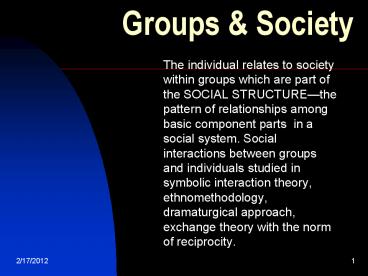Groups PowerPoint PPT Presentation
1 / 18
Title: Groups
1
Groups Society
- The individual relates to society within groups
which are part of the SOCIAL STRUCTUREthe
pattern of relationships among basic component
parts in a social system. Social interactions
between groups and individuals studied in
symbolic interaction theory, ethnomethodology,
dramaturgical approach, exchange theory with the
norm of reciprocity.
2
Social Structure includes status
- Statuses status is a position we hold in
society. Ascribed status is the one you are born
with (male/female) achieved status is one you
earn or achieve (college graduate) master status
an important status that people organize their
lives around. Social class is the category of
people who hold the same status in an unequal
society. YOU OCCUPY A STATUS.
3
Roles
- Roles role is a set of expected behavior
patterns, obligations and privileges attached to
a social status. YOU PLAY A ROLE. Roles include
role expectations (the accepted social norms that
prescribe how a role should be played) role
performance (how you play the role) role strain
(contradictory expectations in a single role)
role conflict (two or more of one persons roles
require contradictory demands)
4
Groups
- collection of people interacting with shared
expectations. NOT an aggregate or a category
5
Kinds of groups
- PRIMARY GROUPSsmall number of people who
interact directly, intimately (families)
SECONDARY GROUPSpeople who interact temporarily,
anonymously, impersonal (formal organizations)
REFERENCE GROUPSa group with a standard we refer
to, make reference to or want to emulate . Size
of groups makes a difference. Small groups of
dyads, triads and up to seven people can engage
in same conversations. Above ten people subgroups
and leaders emerge. Leadership styles include
authoritarian, democratic, laissez-faire
instrumental or expressive. INGROUPS/OUTGROUPS,
reference groups, social networks. Group
cohesiveness and groupthink.
6
Formal Organizations
- kinds of large, secondary groups that are
deliberately designed to achieve specific
objectives. Organization kinds include
voluntary, coercive, utilitarian. Informal
structures opposite of organization includes
informal social networks which depend on rumors
and gossip
7
Bureaucracy
- BUREAUCRACY is a kind of formal organization with
a hierarchical authority structure that operates
under explicit rules procedures. Max Weber
said that increasing levels of bureaucracy lead
to increasing change in social structuresthe
rationalization of society. Bureaucracies need
division of labor, hierarchy, rules, impersonal,
record keeping, administrative staff, career
structure
8
Bureaucracys Problems
- Socialism depends on government bureaucracy to
regulate goods services. This created economic
inefficiencies. Capitalism depends on market to
regulate the flow of goods services but
government bureaucracy needed to regulate
excesses. - Dependence on rule in bureaucracy can lead to
blind adherence which is trained
incapacitygoal displacement where bureaucrats
get so caught up in following rules and filling
out forms that forget purpose of organization - Service without a smile invisible
womancondescending chivalry, supportive
discouragement, benevolent exploitation
9
Oligarchy
- Oligarchies result when there is rule by a few at
the top and authoritarian despots. Robert Michels
called this the iron law of oligarchydemocracy
and large organizations are incompatible. Max
Weber called this an iron cage .
10
Institutions
- Defined as the stable cluster of values, norms,
statuses, roles and groups that develop around a
social needlike education, religion, economy. - Characteristics of institutions include they
are resistant to change which ensures social
stability they are interdependent which means
they work together to uphold the social
structure they change together they are sites
of social problems. - Corporationsa group and bureaucratic institution
that has the status of a real social entity.
11
Society
- Defined as a population that occupies the same
territory, is subject to the same political
authority and participates in a common culture - Sociocultural evolution is the tendency of a
societys social structure and culture to grow
more complex over time. With the creation of
surplus wealth, there is increasing
specialization in a division of labor.
12
Close vs. distant
- Gemeinschaft societieswhere people have a sense
of community and know each other and are close
Gesellschaft societieswhere people have
associations and are strangers to each other. - Mechanical solidarity is where people form groups
and society based on their similarities Organic
solidarity is where people form groups based on
their differences.
13
Types of Societies
- Hunting and gathering, example the Pygmies.
Subsistence economies groups rarely exceed 40
hunt animals gather indigenous foods for
eating members related by kinship marriage no
political institution religion is animism, the
belief in unseen spirits of nature. Simple social
structure.
14
Herding
- Pastoral, example the Turkana. Economies based
on domesticated animals which ensure food and
create surplus wealth. Animals traded for
commodities like gold or weapons which means
political structures develophereditary
chieftainships, slavery, religion as monotheism.
Judaism, Christianity Islam all originated in
pastoral societies (Bibles Psalms).
15
Agriculture
- Horticultural societies. Economies based on
cultivation of plants, but based on slash and
burn technologies rather than cultivation with
plows and draft animals. - Agricultural societies, example the Northern
Indian family. Economies based on invention of
plow and domestication of animals were able to
rework land and stay in one place. Cultivation
of large fields meant creation of surplus wealth,
division of labor. Advanced agricultural
societies led to FEUDALISMa small landowning
elite and many worker peasants. Government
developed, money needed, trade began.
16
Industry
- Industrial societies, example early Europe and
U.S. Economies based on invention of mechanized
production, Industrial Revolution 250 years ago.
Factories, urban cities, CAPITALISM emerges from
feudalism. Democracy takes over monarchies.
17
Post-industry
- Post-industrial societies, example today.
Information and services now centerpiece of
production. Technology and formal knowledge
needed.
18
Transition
- Transitional societies are in-between stages of
development. Called developing societies, the
developing world, the Third World, examples
found in Latin America, Africa, Asia

